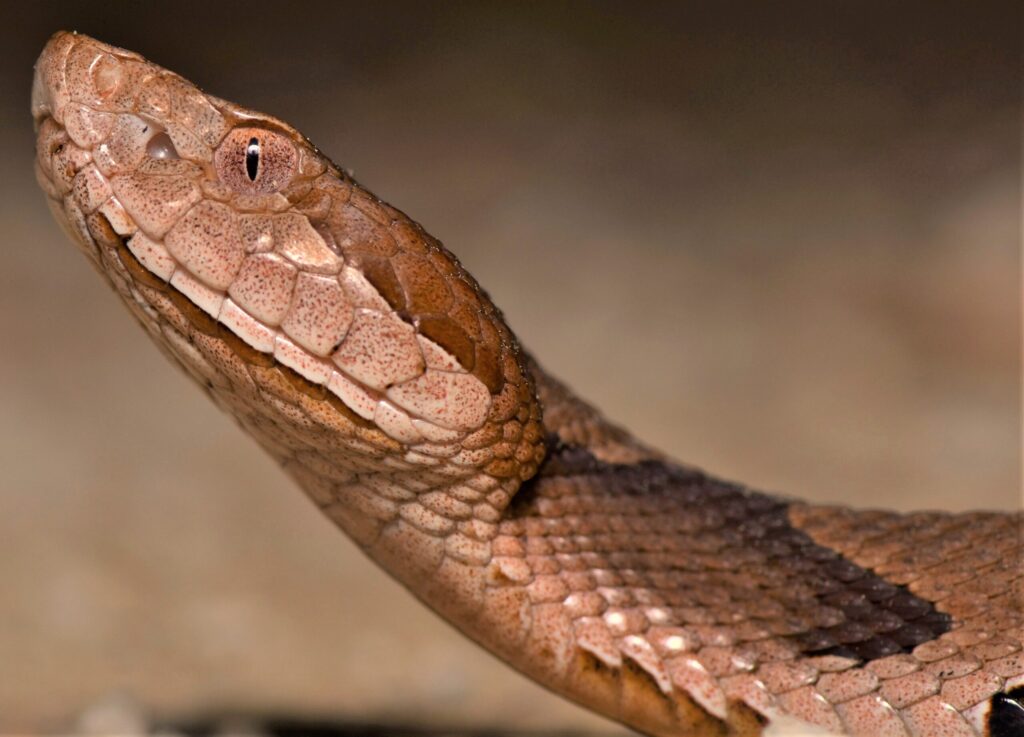When it comes to separating fact from fiction, Snake Island is shrouded in many things.
Mysteries. Legends. Danger.
But there’s no escaping that the most abundant thing on Snake Island is the snakes, to be precise, about 2,000-4,000 of the most venomous snakes in Latin America.
What kind of snakes are on Snake Island?
Snake Island, or the Ilha da Queimada Grande, off the coast of Brazil, is home to several thousand Bothrops insularis, a species of pit viper commonly known as the golden lancehead.
A pit viper is a species of snake that uses heat-sensitive organs between its eyes and nostrils to locate its prey. They include rattlesnakes, copperheads and cottonmouths, among others.
When threatened, a cottonmouth will open its mouth and reveal the white lining but often will not strike at a person. Credit: Whit Gibbons)
“Because of these organs, pit vipers can catch their prey dead-on in total darkness just by detecting its heat,” said Whit Gibbons, a renowned herpetologist and Professor Emeritus at the University of Georgia. Gibbons has been studying snakes for over 60 years.
Are there other ‘snake islands’?
An island full of serpentine predators that can see in the dark and immobilize their prey within minutes might seem like something out of a horror novel, but it’s more common than you might hope. Despite the eponymous name, Snake Island is not the only place this phenomenon occurs.
About 20,000 pit vipers can be found only on Shedao Island in China’s Bohai Sea. In Seahorse Key, part of the Gulf Coast Cedar Keys in Florida, a snake den had to quickly adapt when their primary food source of sea birds abandoned the island. Researchers are not optimistic about their survival.
“Many more ecological and behavioral oddities among snakes are still waiting to be discovered,” said Gibbons.
As researchers study more of these islands, we learn more about the dangers these species face.
Cannibalism. Inbreeding. Starvation.
A lack of biodiversity and the high prices of black market snake venom make these creatures vulnerable to threats beyond your everyday predators.
Take the golden lancehead snake. “Because predation is not a constant issue for the species, their main focal points in survival as individuals and as a species are avoiding environmental extremes, acquiring food and reproduction,” Gibbons said.
As dangerous as they might seem, golden lanceheads have far more to worry about than a few stray humans. Still, it doesn’t stop the stories about their escapades from growing.
Is the golden lancehead dangerous?
Since so few people are allowed on Snake Island, there are no officially recorded incidents of someone dying from a golden lancehead, but the urban legends are numerous.
The final lighthouse keeper and his family chased and killed by the snakes as they fled through the forest.
Pirates buried treasure on the island and left the snakes behind to take care of would-be thieves.
A fisherman found bitten to death in his own boat.
What happens to people bitten by a golden lancehead? The effects would start almost immediately, including:
- brain hemorrhaging,
- kidney failure,
- and muscular tissue necrosis.
These would occur so quickly that even an immediate dose of anti-venom might not do the trick. The venom’s potency might seem like overkill for a species that mostly survives on creatures smaller than a cup of coffee.
However, because this breed of viper exists in such a secluded habitat, there is a lack of diversity in their diet. In fact, the golden lancehead survives almost exclusively on migrating birds that use the island as a resting place. To keep their prey from flying away before they can consume them, the golden lancehead evolved its venom to be up to five times stronger than the average snake, resulting in the highly venomous reptile we know today.
‘Ophidiophobia’
Mainstream media often portrays reptiles as aggressors. From Snakes on a Plane to Jurassic Park, large and scaly creatures are almost always the enemy.
Most snakes understand that humans are too big to eat and have no desire to interact with something much bigger than them.
“When you walk through the woods, many more snakes see you than how many times you see them,” said Gibbons. “They don’t want to be seen. We have done various studies that showed you can walk past a coiled-up rattlesnake, and it won’t move at all. It’s like picking a fight they don’t want to pick. Snakes care nothing about us unless we become a threat.”
The truth is that humans are far further up the food chain than most snakes. They think of us as predators. Though fear of snakes is common, researchers like Gibbons understand how snakes can be useful indicators of an environment’s health, a necessary part of our ecosystem and our survival. How will these “snake islands” add to our knowledge of evolution, biology, and ecology? Only time will tell.
